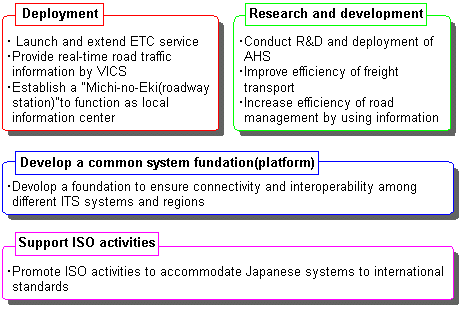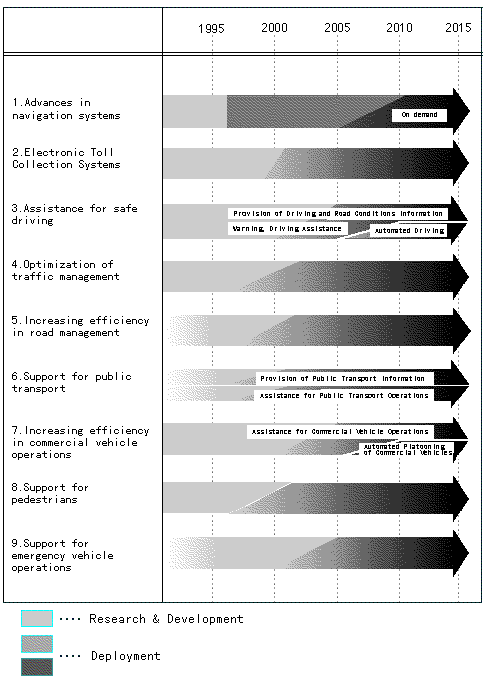

The Role of ITS in the 5-Year Road Improvement Program
On May 29, 1998, the Cabinet approved a 5-Year Road Improvement Program, which attached much importance to the installation of Intelligent Transport Systems (ITS). The Cabinet decision called for the program to "implement the preparation of ITS-compatible roadways, to assist in the development of the advanced information and telecommunications society."
Overview of ITS-Related Projects in the 5-Year Plan
Based on the comprehensive plan for ITS in Japan, the Ministry of Construction (MOC) will aggressively conduct system development, application and implementation, through collaboration with the relevant ministries, private-sector and others.
1) A non-stop electronic toll collection (ETC) system will be installed at some 730 toll booths where maximum benefit is expected, on major routes such as the Metropolitan, Hanshin, Tomei and Meishin Expressways.
Note: "Major locations" refers to the approximately 730 toll booths where maximum benefit is expected, on major routes such as the Metropolitan, Hanshin, Tomei and Meishin Expressways.
2) Information delivery services will be provided in important areas of each prefecture (major cities and restricted area) using the Vehicle Information and Communication System (VICS), which delivers road traffic and other information on a real time basis.
3) The MOC is pressing forward with research and development on the Advanced Cruise-Assist Highway System (AHS), the systems to assist the operation of commercial vehicles and the computerization of road management. In the present 5-year plan, a portion of the AHS-related technology will be put into practice to improve road traffic safety.
4) The MOC will take vigorous steps to prepare standards that will secure compatibility among various systems, and to conduct international standardization activities.

1) Launch and Extend ETC(Electronic Toll Collection) service
ETC systems allow automatic cashless transactions at toll facilities without requiring drivers to stop. This is accomplished by means of short range communication systems and will alleviate congestion at tolling gates. Greater convenience for drivers and reduction of management costs will result. Phased introduction of ETC across the nation will be based on the deployment plan, taking account of operation effectiveness and expected benefit.
The long term goal would be to install ETC at all toll booths across the country. In the 5-Year Program, priorities are given to the Metropolitan Expressways, Tomei and Meishin Expressways where significant benefit from those services can be expected.
| A |
End of 1997 |
End of 2003 |
Long term goal |
|
Rate of ETC (non-stop tolling system) service Availability |
0 % |
deployment at main tollgates |
deployment across the country |
|
0 tollgate |
730 tollgates |
1,300 tollgates |
Reference:
2) Provision of real-time road traffic information
VICS(Vehicle Information and Communication System) provides timely and detailed traffic information on congestion, parking availability and traffic restrictions due to accidents or harsh weather in order to relieve congestion, enhance logistics efficiency secure safe traffic, and to relieve environmental impact. The 5-year Road Improvement Program declares that VICS will initiate traffic information service in major areas (major cities and zones under traffic restriction) of each prefecture in Japan.
To improve interconnection with other means of transportation, for instance, air travel, real-time flight information is provided at parking areas adjacent to major international airports.
| A | 1997 | 2003 | The long term goal |
| Spatial rate where VICS service is available |
about 20% | near completion of deployment across the country | near completion of deployment across the country |
Reference:
3) Establishment of local information center
Road traffic information will be provided at "Michi-no-ekis"(roadway stations) and service areas along with local community information, as part of the efforts to improve imformation service in local areas.
b) Research and Development
MOC is to conduct active R&D on ITS based on the Comprehensive Plan for ITS in cooperation with relevant ministerial bodies and industries.

1) R&D development of AHS(Advanced Cruise-Assist Highway System)
MOC is to conduct active R&D activities to develop a safe driving system which provides danger warning and assistance to drivers. The ultimate goal is to develop fully automated vehicle control.
The 5-year Road Improvement Program declares that some of the safe driving assistance technology (danger warning at tail-end and prevention of lane departure) will be realized by developing road infrastructure and domestic standards in coordination with corresponding activities in Europe and the United States.
To proceed efficiency in logistics, MOC is to conduct R&D to establish advanced traffic information systems to assist efficient operation of (commercial vehicles). To improve efficiency of road management, MOC is to develop road management information system by unifying the format of road information data and compiling databases, and to develop a system to manage special commercial vehicles.
1) To efficiently construct the integrated, organically linked system MOC will clarify the whole image of ITS systems (architecture) and prepare standards to ensure compatibility among different ITS systems.
d) Support ISO activities
1) The MOC will work toward the realization of the ITS from an international perspective, by exchanging information on bilateral levels and at international conferences such as the ITS World Congress. In addition, MOC will actively assist in the analysis of proposals from each country to the International Organization for Standardization (ISO) and in the development of Japanese proposals to ensure that the Japanese systems will conform to international standards.
|
| |
All Rights Reserved, Copyright © 2004 Ministry of Land, Infrastructure, Transport and Tourism |